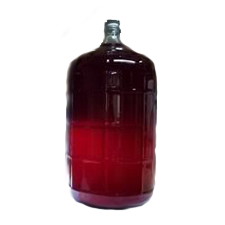The Lees You Know: The Art and Science of Managing Sediment in Winemaking
Posted by Matteo Lahm on 17th Apr 2024
Today, we're diving deep into the bottom of your carboy where the lees lie. If you're scratching your head wondering, "What on earth are lees?" or if you're a seasoned winemaker looking to refine your racking skills, you've come to the right place.
Let's start by uncorking the mystery of lees. In the simplest terms, lees are the sediment that settles at the bottom of your wine container during and after fermentation. This sediment is a cocktail of dead yeast cells and fruit particles. Now, before you start viewing lees as the unwanted dregs of winemaking, let's clarify something: not all lees are created equal nor should you treat them equally in your winemaking process.
In the realm of lees, we have two distinct types: gross lees and fine lees. The gross lees are the thick layer of yeast and fruit crud that forms in the initial days after pressing the wine. Their name is indicative of both their size and character. They are big, and gross and can be like the unruly party guests who overstay their welcome. If your wine sits on a stagnant, thick layer of gross lees for too long, it can lead to some serious wine woes.

Think of a pile of disgruntled, unfed yeast cells starting to create hydrogen sulfide, which gives off a less than pleasant rotten egg smell. When yeast organisms are starved, they get ornery and mount defenses that are indicative of stress. If left unchecked, this can morph into the dreaded mercaptan, which imparts a burnt rubber taste to your wine. Moreover, any leftover nutrients that may have fallen out of the wine after fermentation can also feed unfriendly bacteria and yeasts, which can lead to spoilage. Once they have done their job of fermentation, they have performed their required services and it is time for them to part ways with you, and your wine.
Now, let's shift gears and talk about the fine lees. These are the thin sediment layer that forms later on, and they can actually be beneficial. Long-term contact with fine lees can actually enhance the quality of your wine. They are a natural byproduct of fermentation that adds a bit more mouthfeel.
This process, known as Bâtonnage, is commonly used when making wines like Chardonnay. The fine lees contribute to the buttery consistency that Chardonnay lovers adore. Some red wines, like Pinot Noir and Syrah, can also benefit from this process, adding depth and complexity to their flavor profiles. So if you want a more buttery consistency, don’t be afraid to leave your wine on the fine lees for a month or two. Just keep an eye on it and if you see the sediment layer getting a bit thick, rack again. It means there are more fine lees still suspended that need more space to settle out of your wine.
So, how do we navigate this tale of two lees? The answer lies in the art of racking. Just in case you are a newbie and you have just started your investigation into wine making techniques, let’s define racking. It is the process of transferring wine from one container to another by siphoning, leaving behind the sediment or lees. You have to transfer with this method to leave the lees on the bottom on the container.
The first racking should occur shortly after pressing the wine or if you are working with juice or a kit, after fermentation is complete. This is a crucial step as it separates the wine from the thick layer of gross lees.
The second racking comes into play when the lees pile up to an uncomfortable level once again. For red wine, this ideally happens after malolactic fermentation has completed or when the sediment layer is noticeably thick. If you are making a white wine from fresh grapes, your first racking is after you press and before fermentation. The second racking is generally after fermentation has completed and things have settled out for about two days. If you are working with juice or a kit, you will have much less sediment but should still rack after primary fermentation to lessen the concentration of the larger lees to allow the fine lees to work their magic.
The third and final racking should occur at the time of bottling. At this stage, the wine should have no visible haze and no off smells. This racking is a two-stage process, where the wine is first racked off the remaining lees into a temporary blending vessel, and then any final blending occurs. If your wine is still showing noticeable sediment, you may want to rack one more time before bottling or treat your wine with fining agents to clear it entirely before your final racking.
Now, you might be wondering, "What if I rack too many times?" Well, overzealous racking can diminish aromatics and often cause full-blown oxidation. Each time you rack the wine, a small bit of oxygen will be absorbed which can react with volatile aroma compounds. So, remember, don't rack unless you have a reason to rack. Furthermore, racking too many times early in the process can cause stripping which is when you remove too much sediment too quickly. As we have learned, those fine lees have important contributions to make to your wine so be patient and let them settle out on their own.
In conclusion, managing lees through timely racking is an essential aspect of winemaking. It's a delicate balancing act that can significantly impact the taste, aroma, and clarity of your wine. So, the next time you sip on a glass of wine, you'll appreciate the journey it took from the vineyard to your glass. Here's to the lees we know and the wines we love!

